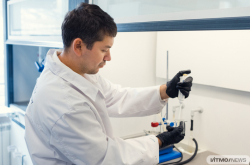Cancer is something we want to get rid of. If a patient comes with a bacteria-caused disease, what do we do? We choose and prescribe them an antibiotic treatment which kills off harmful bacteria. But how to find an antibiotic for cancer? The main problem we face here is that we can’t create a drug that would target tumorous cells and nothing else.
This is the reason why therapeutic window has become the key principle for developing anticancer drugs. It implies that drugs that are designed are effective when taken in specific non-toxic doses at a given time. This way, the drug will stave off cancerous growth without hurting other cells. The wider the therapeutic window, the better is the drug developed.

The width of the therapeutic window depends on several factors. The first is the drug’s target, or, in other words, the parts of the tumor the drug will interact with. The second is the drug’s own properties, from pharmacokinetic (which describe how the treatment affects the tumor and healthy tissues) to general (how the drug impacts on other molecules present in the body).
History of cancer drugs development
The search for anticancer drugs dates back to the Second World War. Despite the universal ban on chemical warfare, all countries still prepared for the possible eventuality of chemical weapons being used by warring parties. It is for this purpose that the US used to store mustard gas on their ships. Several of these ships were attacked by Nazi Germany on December 2, 1943, in the Italian city of Bari. The ensuing fire outbreak caused a major mustard gas leak, harming as much as a thousand of American marines. An on-the-spot investigation by physicists established that the exposure to the dangerous gas resulted in a far-reaching suppression of lymphoid and myeloid cells in the bodies of casualties. These findings underpinned Dr. Stewart F. Alexander’s later suggestion that mustard gas can be used to suppress cancer cells’ growth. This research thread was then picked up by Louis Goodman and Alfred Gilman, who modified mustard gas to make it suitable for lab work, and began using it to cure cancer patients.

Conventional drugs
When I was just starting to work in this field, hospitals and research centers only used the drugs we now know as conventional. Many of these treatments were found thanks to independence mechanisms of cancer cells. Others were developed with the goal of targeting the general properties of cancer-affected and healthy cells.
All these drugs have a very narrow therapeutic window, which makes them unavoidably harmful to patients. You may have seen what chemotherapy does to the human body: hair loss is one of the many unpleasant consequences of this conventional treatment.
But such treatments do have a healing effect. They are very efficient and fast in destroying target cells, and much more often than not tumors aren’t able to develop a mechanism to resist it.

As an example, rectal cancer was for a long time considered as dangerous as any other type of cancer. But then scientists discovered a whole new class of conventional drugs targeting the disease, and now 90% of patients are able to go back to health thanks to these treatments.
Among the main groups of conventional drugs are DNA-harming agents (which are the cheapest anticancer drugs available), topoisomerases (which impact on the DNA topology), metabolic antagonists (which slow down biochemical processes that encourage cancer cells’ growth), and microtubule agents (which are combinations of different pharmaceutical agents for curing liquid and solid tumors).
Targeted drugs
The majority of drugs developed today are targeted, or cancer-type specific. Unlike their conventional counterparts, these have a wide therapeutic window, targeting tumor tissues and leaving healthy tissues untouched. Another special feature of targeted drugs is that we have to be extremely careful in matching them to patients. What does the tumor look like, does it have a mutation, what is the patient’s clinical record; these factors are paramount when choosing the right drug for each specific case.

Unfortunately, the huge problem with targeted drugs is that it’s easy for cancer cells to develop resistance to this group of treatment. I had cases where it seemed like a patient had made a complete recovery from melanoma thanks to this cure, but then the cancer struck back with renewed strength.
In terms of their appearance, targeted drugs come in the form of small molecules or monoclonal antibodies (i.e. clones of immune cells). Belonging to this type of treatment are kinase inhibitors (which have a selective impact on growth processes), growth promoting substances and receptor inhibitors, hormone antagonists (which affect target cells by causing hormonal disruptions), and proteasome inhibitors (which block complexes that destroy proteins).
Drug development process
It’s impossible to make a universal drug for all targets. A target molecule has to have a stereochemically unique cavity (also known as a ‘pocket’) able to house the drug. In modern research, scientists choose proteins, often pocketless ones, as the one and only apposite target. You also need to achieve a clear identification of the catalytic crevice that binds the natural small-molecule ligand (a chemical compound which enters in a complex with proteins, causing certain effects as a result).

The development of effective anticancer drugs also depends on the correct identification of molecule classes. The key term to know here is pharmacophore. It describes the properties of the drug that ensure the optimal interaction with a biological target and a timely start of the whole reaction.
Structure-guided drug design is slowly but surely becoming the most popular approach to developing drugs. Our first step when designing a drug is uploading structural information on targeted molecules in the 3D format. Then we work with it through X-ray crystallography. The diffraction (change of direction) of X-rays helps us indicate areas with high electron density, and we also use it to assign atom positions in the molecules.
All approaches to drug development can be divided into two main categories. Old approaches work by modifying existing components such as hormones, metabolites, and even drugs as a whole. Modern approaches are based on high throughput screening, which is batch testing enabled by robotic systems.

The process of discovering a drug usually lasts for three to four years, and developing this drug takes from four to eight years to complete. We start by identifying the target (a protein or a cell), then we conduct the necessary experiments on animals (both of these are discovery stages), and only after that move on to the drug creation stage. This consists of trialing a drug for checking whether it’s effective and safe for humans, registering the drug and signing a nondisclosure agreement.
The drug development journey isn’t one without problems, of course, the most frequent being the lack of effectiveness (encountered in 33% of cases), toxicity (33% of cases), pharmacokinetics (25%) and commercialization (9% of cases).
I would like to conclude by saying that the oft-experienced prolongations in the clinical trial stage can lead to a significant increase of the cost of the development process, making it a total of 500 million to a billion dollars in expenses. And this is the main reason why anticancer drugs come with such a big price-tag.





